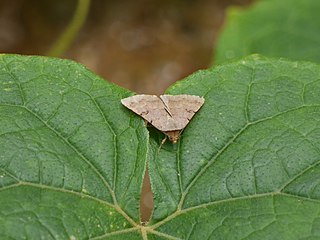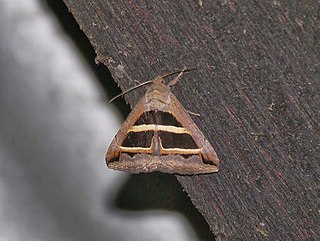Anumeta is a genus of moths in the family Erebidae.
Rivula tanitalis is a species of moth of the family Noctuidae first described by Hans Rebel in 1912. It is found in Morocco, Egypt, Algeria, Malta, Crete, Greece, Lebanon, Iraq, Iran, Saudi Arabia, Yemen and Israel.

Plecoptera reflexa is a species of moth of the family Noctuidae first described by Achille Guenée in 1852. It is mainly found in India, but its range extends west as far as the central and northern parts of the coastal plains of Israel.
Plecoptera inquinata is a species of moth of the family Noctuidae first described by Julius Lederer in 1857. It is found in Turkey, Azerbaijan, Iran, Lebanon and Israel.
Exophyla rectangularis is a moth of the family Noctuidae first described by Carl Geyer in 1828. It is found in Ukraine, Romania, Bulgaria, Albania, Greece, Montenegro, Croatia, northern Italy, Mediterranean Turkey, Lebanon, Israel and Turkmenistan.
Autophila limbata is a moth of the family Noctuidae first described by Otto Staudinger in 1871. It is found in southern France, southern Italy, the Iberian Peninsula, Greece, the Crimea, the Near East, Iran, Transcaucasia and Turkmenistan.
Iranada turcorum is a moth of the family Noctuidae first described by Hans Zerny in 1915. It is found in Syria, Lebanon, Israel, Jordan, Egypt, Iraq, Oman and south-western Iran.

Ulotrichopus tinctipennis is a moth of the family Noctuidae first described by George Hampson in 1902. It is found in Botswana, Burkina Faso, Djibouti, Egypt, Ethiopia, Kenya, Mauritania, Namibia, Nigeria, Oman, Saudi Arabia, Somalia, Sudan, Eswatini, Tanzania, United Arab Emirates, Yemen, Zimbabwe, Israel and Jordan.
Dysgonia rogenhoferi is a moth of the family Noctuidae first described by Otto Bohatsch in 1880. It is found in Lebanon, Israel, Iraq, Arabia, Turkmenistan, northern Iran, Uzbekistan, the European part of southern Russia, Azerbaijan and Pakistan.

Grammodes bifasciata is a moth of the family Erebidae first described by Vincenzo Petagna in 1787. It is found in Madagascar, eastern Africa, North Africa and other parts of the Mediterranean Basin, including south of France and Israel.

Anumeta atrosignata is a moth of the family Erebidae first described by Francis Walker in 1858. It is found in the Arabian Desert, the Sinai, Israel, east to north-western India.
Anumeta straminea is a moth of the family Erebidae first described by Andreas Bang-Haas in 1906. It is found from the Sahara and the Arabian Desert to Bahrain and northern Oman. Furthermore, it is found in the Arava Valley and the Dead Sea area of Israel.
Pericyma squalens is a moth of the family Noctuidae first described by Julius Lederer in 1855. It is found in south-eastern Turkey, Iran, Iraq, Afghanistan, Turkmenistan, Kuwait, Saudi Arabia, Egypt, Lebanon, Israel and Jordan.
Heteropalpia profesta is a moth of the family Noctuidae first described by Hugo Theodor Christoph in 1887. It is found in the Near East, the Middle East, Iraq, Iran, Afghanistan, Transcaucasia, Turkmenistan and the Arabian Peninsula.
Tytroca leucoptera is a moth of the family Noctuidae first described by George Hampson in 1896. It is found in the Arabian Peninsula and all deserts of North Africa.
Gnamptonyx innexa is a species of moth in the family Erebidae first described by Francis Walker in 1858. The species is found from Morocco to the Arabian Peninsula, Israel, Iran, Afghanistan, Pakistan and western India.
Epharmottomena eremophila is a moth of the family Noctuidae first described by Hans Rebel in 1895. It is found from Morocco and the western parts of the Sahara, to Sinai, Israel and Syria.

Chazaria incarnata is a species of moth of the family Noctuidae. It is found on the Canary Islands and on the Iberian Peninsula, east to Italy, Serbia, Romania, Bulgaria, North Macedonia and Greece. Further east it is found to southern and eastern Russia in the north and Turkey, the Dead Sea region of Israel and Iran.
The Toxocampinae are a subfamily of moths in the family Erebidae. Moths in the subfamily typically have a primitive form of genital claspers similar to those of some subfamilies of the Noctuidae.



